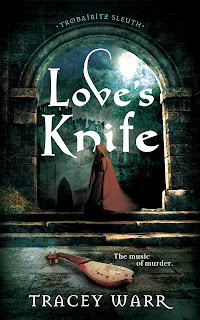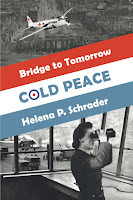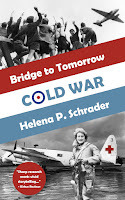Historical Figures in Historical Fiction -- A Guest Post by Tracey Warr
Tracey Warr was born in London and lives in a tiny medievalhouse next to a river in southern France, where she is surrounded byspectacular castles, such as Najac and Penne, and fascinating stories abouttheir medieval occupants. She draws on archeological sites, old maps,chronicles, poems and museum objects to create fictional worlds for her readersto step into. She has published six historical novels. Before becoming afull-time writer, she worked as a contemporary art curator and art historyacademic. Find out more at: https://meandabooks.com
Biography ofbiographical historical fiction?
The 12th centurymonk chronicler, William of Malmesbury described the heroine of my first novelas ‘afflicted with a Godless female itch’. That seemed a good reason to me towrite about her. Almodis de La Marche was married three times and was countessof Toulouse and then countess of Barcelona in the 11th century. Herthird husband, Ramon Berenguer of Barcelona, kidnapped her from her secondhusband, Pons of Toulouse, possibly at her contrivance. Almodis’ threemarriages were the reason for William of Malmesbury’s harsh words. The popeexcommunicated Almodis and Ramon for that third marriage.
The count ofBarcelona described Almodis as ‘radiant upon Earth’. She was a powerful femalelord, who is documented as active in the rule of Toulouse and then Barcelona.She also found time to have eleven children. (She is the great greatgrandmother of Eleanor of Aquitaine.) Researching her life yielded richmaterial, and my dilemma was whether to write her biography or a novel abouther. In the end, the fiction won out. Writing a novel gave me leeway to use theevidence about her but to imagine her personality and story into the gaps. Shegave birth to two sets of twins and, in the novel, I made her an identical twinwith her sister Raingarde, which may or may not have been true. I met a womanwho was an identical twin, who told me about some of her experiences oftwinness. In a novel, I was able to blend historical facts with incidents andexperiences from my own life that chimed with the needs of the story.
Having theframework of a real life to work with in fiction gives me anchors and handholdsin research. There are some facts, dates, relationships, events to find outabout and imagine among, rather than being in a complete starting vacuum. Sincemy heroines are medieval women, there are scant facts known about them so thereis plenty of space for imaginative roaming and creation.
Medieval birthdates were rarely recorded. I have to create credible timelines based onwedding dates when they are known, periods of pregnancy, dates of birth ofchildren, and so on. And then I augment the evidence with a lot of secondarysources – biographies, histories, journal articles, genealogies and reading onparticular topics, such as sex or food in the middle ages.
Of course acharacter in a novel, whether based on a real historical figure or not, isstill a fictional character. In the case of a medieval women, what she lookedlike, how she responded in various situations, her desires, motivations, fears,affections are all coming from my imagination. I am aiming for credibilityrather than authenticity.
Handholds forResearch
Theprotagonists of my first five novels are real women who I found in medieval chronicles.They receive scant attention in these chronicles – often just a sentence, atmost a paragraph – but that was enough to spur me into research about andaround them and to fire my imagination to fill in the gaps. I am looking forwomen who buck the stereotype of medieval women.
The chroniclerAdemar of Chabannes wrote that Emma of Segur, viscountess of Limoges, was kidnappedby vikings from a monastery on the coast of Aquitaine in the 10th century. Shebecame the heroine of my second novel, The Viking Hostage. The vikingsheld Emma hostage for two years while her husband was struggling to raise theenormous ransom that was demanded for her return. What happened to Emma duringthose two years? Ademar has nothing to say on the subject, so I decided toimagine my way into an answer.
DebateableHistory, Reading People
Nest ferch Rhyswas the daughter of the last independent king in Wales during the protractedNorman conquest. Unlike England, which was conquered in a day at Hastings, theconquest of Wales took many decades. Nest’s life was so turbulent that I hadenough material to write a trilogy of novels about her (Daughter of the LastKing, The Drowned Court, and The Anarchy).
Nest was themistress of the Norman king Henry I and had a son with him. She was the wife ofthe Norman steward of her father’s former strongholds, Gerald FitzWalter. Itwas a common strategy for the Norman invaders to take Anglo-Saxon and Welshwomen, the daughters of their vanquished foes, as their wives to lendcredibility to their territorial appropriations. These wives provided a bridgeto the conquered communities.
The Chronicleof the Princes (Brut yTwysogion) recounts how Nest was kidnapped from her Norman husband Geraldby the Welsh prince Owain ap Cadwallader. When Owain attacked the castle, Geraldescaped down the castle’s toilet chute into the moat, apparently at Nest’ssuggestion. After a couple of years, she was returned to Gerald through thenegotiations of her former lover, King Henry. Gerald later killed Owain in askirmish and then died himself, perhaps from wounds inflicted in the fight.King Henry then married Nest off to yet another Norman, Stephen de Marais, theconstable of another of her father’s appropriated castles at Ceredigion.
The women in myfirst five novels were all kidnapped. This ripping from one situation toanother is a trope that interests me. Nest has been described as ‘the Helen ofTroy of Wales’ and several historians have suggested that her string of loverswas the result of her beauty or perhaps even her promiscuity. That made mequite angry and I wanted to write her fictional story to try to get to thetruth of her story – or at least one possible truth. It has been suggested thatshe colluded in Owain’s kidnap of her. She had been living with Gerald then forten years and had three children with him. Clearly, she was caught between theopposing camps of the Normans and the Welsh, but it seemed unlikely to me thatshe would have willingly left Gerald and her small children.
I look at whatI feel the realistic psychology and motivations of my characters might be.Another novelist would interpret the same historical person and event in adifferent way. They are always a fictional creation. I make judgement calls ongrey areas of history, based on the needs of my story and the consistency ofthe character I am creating. I am reading the evidence – about Nest or Almodis– weighing the the misogyny of their societies and our own, and striving tocreate a character with consistency and credibility.
Since I amwriting about a real woman and researching her context, many of my othercharacters are also based on real people. In particular, I enjoyed creatingKing Henry who had at least 23 illegitimate children and many mistresses, butalso took care of those mistresses and children. There is always moreinformation available about the men than about the women. The majority ofavailable material is about the medieval nobility. My non-noble characters,such as maids and stewards, all have to be imagined.
In a novel, Iam able to take a very slight historical detail and make good use of it. Nest’sfinal lover may have been Hayt, the Sheriff of Pembroke and they may have had achild. He was a real person recorded in the court rolls but not much else isknown about him. His name suggests that he was Flemish. I met a charming Dutchman around the time that I was creating Haith (as he became in the novel) and Iused him as the physical model for Nest’s final lover.
Real historicalfigures, fictional characters
My first fivenovels could be termed biographical historical fiction. I tell most of thelives of the women in a single novel or in a trilogy of novels. For my mostrecent book, Love’s Knife, however, I decided to take a different tack.My protagonist is a fictional character and not based on a real historicalcharacter. I wanted the book’s action to take place in a short span of time –nine months. Nevertheless, one of the main secondary characters is based on areal woman and the facts known about her life give me a framework to workwithin for what I intend to be a long-running series.
I often have apoet as a character in the novels. A female troubadour in Almodis, askald in The Viking Hostage, and a bard in the Conquest trilogy aboutNest. In Love’s Knife, the protagonist, Beatriz de Farrera, is a femaletroubadour. These characters allow me to include fragments of the real medievalvoice in the novels. Beatriz’s patron is the real historical character, Philippaof Toulouse, who later becomes the Duchess of Aquitaine. (She was Almodis’granddaughter and the grandmother of Eleanor of Aquitaine.) Love’s Knifeis book 1 in the Trobairitz Sleuth series and I’m currently having funresearching Philippa’s life and imagining Beatriz’s.
 https://books2read.com/LovesKnife
https://books2read.com/LovesKnifeBlog Host, Helena P. Schrader, is the author of
the Bridge to Tomorrow Trilogy.
The first two volumes are available now, the third Volume will be released later this year.

The first battle of the Cold War is about to begin....
Berlin 1948. In the ruins ofHitler’s capital, former RAF officers, a woman pilot, and the victim of Russianbrutality form an air ambulance company. But the West is on a collision coursewith Stalin’s aggression and Berlin is about to become a flashpoint. World WarThree is only a misstep away. Buy Now
Berlin is under siege. More than twomillion civilians must be supplied by air -- or surrender to Stalin's oppression.
USAF Captain J.B. Baronowsky and RAF FlightLieutenant Kit Moran once risked their lives to drop high explosives on Berlin.They are about to deliver milk, flour and children’s shoes instead. Meanwhile,two women pilots are flying an air ambulance that carries malnourished andabandoned children to freedom in the West. Until General Winter deploys on theside of Russia. Buy now!
Based on historical events, award-winning and best-selling novelistHelena P. Schrader delivers an insightful, exciting and moving tale about howformer enemies became friends in the face of Russian aggression — and how closethe Berlin Airlift came to failing.
Winning a war with milk, coal and candy!




